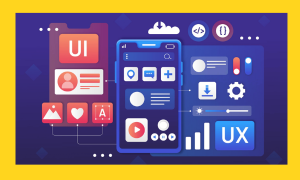UI developers are responsible for designing and developing the visual and interactive components of websites, web applications, and mobile applications. They are experts in creating user interfaces that are aesthetically pleasing, easy to use, and provide a seamless user experience. A UI developer’s job is to ensure that the interface’s technical aspects work seamlessly with the visual and creative elements.
UI developers must possess a combination of technical and design skills. They must be proficient in front-end web development technologies such as HTML, CSS, and JavaScript. Knowledge of design tools such as Photoshop, Sketch, and Figma is also essential. In addition to technical skills, UI developers must have strong design skills to create visually appealing interfaces that are easy to use. They must also have good communication and collaboration skills to work effectively with other members of the development team.
Key Takeaways
- A UI developer is responsible for designing and developing the visual and interactive components of websites, web applications, and mobile applications.
- UI developers must possess a combination of technical and design skills.
- In addition to technical skills, UI developers must have strong design skills and good communication and collaboration skills to work effectively with other members of the development team.
Defining the Role of a UI Developer
A UI developer, short for User Interface developer, is responsible for designing and implementing the user interface of a website or application. In other words, they create the visual elements of the digital product that users interact with. This includes everything from buttons and menus to the overall layout and design of the product.
UI developers work closely with UX designers, who are responsible for creating the overall user experience of a product. While UX designers focus on the user journey and how the product should function, UI developers focus on how the product should look and feel. They take the wireframes and prototypes created by UX designers and turn them into a functional, visually appealing product.
To be successful in this role, a UI developer must have a strong understanding of web design principles, as well as proficiency in front-end development languages such as HTML, CSS, and JavaScript. They must also be familiar with design software such as Sketch, Photoshop, and Illustrator.
In addition to technical skills, a UI developer must also have a keen eye for design and attention to detail. They must be able to create visually appealing designs that are both functional and easy to use. Communication skills are also important, as UI developers must be able to work collaboratively with other members of the development team, including UX designers, back-end developers, and project managers.
Essential Technical Skills
UI developers require a diverse set of technical skills to design and implement effective user interfaces. Here are some of the essential technical skills that UI developers must have:
Proficiency in HTML, CSS, and JavaScript
UI developers must be proficient in HTML, CSS, and JavaScript to create and manipulate web pages. HTML is used to structure content, CSS is used to style content, and JavaScript is used to add interactivity to web pages. A UI developer must be able to write clean, well-organized code in these languages to create user interfaces that are both functional and visually appealing.
Familiarity with UI Frameworks and Libraries
UI developers must be familiar with UI frameworks and libraries, such as Bootstrap, Foundation, and Materialize, which provide pre-built UI components and styles. These frameworks and libraries help UI developers to create responsive and visually consistent user interfaces quickly and efficiently.

Understanding of Responsive and Adaptive Design
UI developers must have a good understanding of responsive and adaptive design. Responsive design ensures that user interfaces are optimized for different screen sizes, while adaptive design ensures that user interfaces are optimized for different devices. A UI developer must be able to design and implement user interfaces that are both responsive and adaptive to provide the best user experience across different devices.
Experience with Version Control Systems
UI developers must have experience with version control systems, such as Git, which allow them to track changes to code and collaborate with other developers. Version control systems help UI developers to manage code changes, track bugs, and revert to previous versions of code if necessary. A UI developer must be able to use version control systems effectively to ensure that user interfaces are delivered on time and with high quality.
Core Design Skills
UI developers must have a strong understanding of the principles of visual design, user-centered design methodologies, and prototyping and wireframing tools. These core design skills form the foundation of UI development and are essential for creating intuitive and visually appealing user interfaces.
Principles of Visual Design
UI developers must have a solid grasp of the principles of visual design, such as color theory, typography, and layout. They should be able to create designs that are aesthetically pleasing, easy to navigate, and consistent with the brand’s visual identity. UI developers must also understand how to create designs that are accessible to users with disabilities and are optimized for different devices and screen sizes.
User-Centered Design Methodologies
UI developers must be familiar with user-centered design methodologies, which involve understanding the needs and preferences of the target audience and designing interfaces that meet their requirements. This involves conducting user research, creating user personas, and testing designs with real users to ensure that they are effective and easy to use.
Prototyping and Wireframing Tools
UI developers must be proficient in using prototyping and wireframing tools to create interactive and functional designs. These tools allow developers to quickly create and test different design concepts, iterate on designs based on user feedback, and refine the final product before it is launched. Some popular prototyping and wireframing tools include Sketch, Figma, and Adobe XD.
In summary, UI developers must possess a strong foundation in design principles, user-centered design methodologies, and prototyping and wireframing tools to create effective and engaging user interfaces.
Soft Skills for UI Developers
UI development requires a unique combination of technical and soft skills. While technical skills are vital for designing and developing user interfaces, soft skills are equally important for successful collaboration with team members, clients, and stakeholders. Here are some of the most important soft skills for UI developers:
Effective Communication
UI developers must be able to communicate effectively with team members, clients, and stakeholders to ensure that everyone is on the same page. They must be able to explain technical concepts in simple terms and be receptive to feedback. Good communication skills also help UI developers to build strong relationships with team members and clients, which can lead to better collaboration and successful project outcomes.
Problem-Solving Abilities
Problem-solving is a critical skill for UI developers. They must be able to identify problems, analyze data, and come up with effective solutions. UI developers must also be able to think creatively and outside the box to find innovative solutions to complex problems. Good problem-solving skills help UI developers to deliver high-quality user interfaces that meet client requirements and user expectations.
Team Collaboration
UI development is a team effort, and UI developers must be able to collaborate effectively with other team members. They must be able to work well in a team environment, be open to feedback, and be willing to help others. Good team collaboration skills help UI developers to build strong relationships with team members and create a positive work environment that fosters creativity and innovation.
In conclusion, UI developers require a unique combination of technical and soft skills to succeed in their roles. Effective communication, problem-solving abilities, and team collaboration are just a few of the essential soft skills that UI developers need to develop to become successful in their careers.
Development Tools and Environments
UI developers rely on a wide range of tools and environments to design, develop, and test user interfaces. In this section, we will discuss some of the most popular tools and environments used by UI developers.
Integrated Development Environments (IDEs)
Integrated Development Environments (IDEs) are software applications that provide UI developers with a comprehensive set of tools to write, test, and debug code. IDEs are designed to streamline the development process by providing features like code completion, syntax highlighting, and debugging tools. Some of the most popular IDEs used by UI developers include:
- Visual Studio Code: A free, lightweight, and versatile IDE that supports a wide range of programming languages and extensions.
- Sublime Text: A fast and customizable IDE that supports multiple selections, split editing, and other advanced features.
- Atom: A modern and hackable IDE that is highly customizable and extensible.
Debugging and Testing Tools
Debugging and testing are critical components of the UI development process. UI developers use a variety of tools to ensure that their code is error-free and meets the required standards. Some of the most popular debugging and testing tools used by UI developers include:
- Chrome DevTools: A set of web developer tools built directly into the Google Chrome browser. DevTools provides a variety of tools for debugging, testing, and optimizing web pages.
- Selenium: A popular open-source testing framework that allows UI developers to automate web browsers.
- Jest: A JavaScript testing framework that is used by many UI developers to test their code.
UI developers must be proficient in using these tools and environments to design, develop, and test user interfaces. By leveraging the power of these tools, UI developers can create high-quality user interfaces that provide the best possible user experience.
Performance Optimization Techniques
UI Developers need to be skilled in techniques that reduce load times and improve the efficiency of web applications. Performance optimization is a top skill for UI Developers as user expectations for fast and responsive web applications continue to rise.
One technique is to optimize images by compressing them and reducing their file size. This can be achieved by using image optimization tools or by manually compressing the images. Another technique is to use a content delivery network (CDN) to deliver static assets such as images, CSS, and JavaScript files. This can help to reduce the load time of the website and improve its performance.
UI Developers should also be familiar with browser caching techniques. This involves storing frequently used data such as images, CSS, and JavaScript files in the browser cache so that they can be loaded more quickly. Another technique is to use lazy loading for images and other assets that are not immediately visible on the page. This can help to reduce the load time of the website and improve its performance.
In addition to these techniques, UI Developers should also be familiar with code optimization techniques. This involves writing efficient and optimized code that is easy to read and maintain. This can help to reduce the load time of the website and improve its performance.

Accessibility and Internationalization
UI developers have a responsibility to ensure that their designs are accessible to all users, including those with disabilities. This involves designing interfaces that are easy to navigate, have clear and concise labeling, and are compatible with assistive technologies such as screen readers.
To achieve accessibility, UI developers must follow international standards and guidelines such as the Web Content Accessibility Guidelines (WCAG) 2.1. These guidelines provide a framework for designing accessible interfaces and cover areas such as keyboard accessibility, color contrast, and alternative text for images.
In addition to accessibility, UI developers must also consider internationalization when designing interfaces. This involves designing interfaces that can be easily adapted to different languages, cultures, and regions. This includes using Unicode for text encoding, designing interfaces that can accommodate different text directions (such as right-to-left for Arabic and Hebrew), and ensuring that interfaces can handle different date and time formats.
UI developers can use tools such as localization software to help with internationalization. These tools can automate the process of translating and adapting interfaces to different languages and regions.
By designing interfaces that are both accessible and internationalized, UI developers can ensure that their designs are usable by the widest possible audience. This not only benefits users with disabilities and those in different regions, but also improves the overall user experience for all users.
Continual Learning and Adaptation
UI development is a field that is constantly evolving, which means that UI developers need to keep up with the latest trends and technologies to stay relevant. Continuous learning and adaptation are essential skills for UI developers in 2024.
Continuous learning involves expanding one’s skills and knowledge as part of an ongoing process of self-improvement or professional development. It requires intellectual curiosity and a desire to adopt new skills. UI developers must be willing to learn new technologies and techniques to keep up with the ever-changing landscape of UI development.
Adaptation is also crucial for UI developers. They must be able to adapt to new technologies and work environments quickly. UI development is a collaborative field, and UI developers must be able to work with others effectively. They must be able to communicate with team members and clients clearly and effectively.
To stay up-to-date with the latest trends and technologies, UI developers can attend conferences, workshops, and training sessions. They can also read industry publications and blogs. They should also experiment with new technologies and techniques to see what works best for them.
In summary, continual learning and adaptation are essential skills for UI developers in 2024. UI developers must be willing to learn new technologies and techniques to stay relevant in the ever-changing landscape of UI development. They must also be able to adapt to new technologies and work environments quickly.

